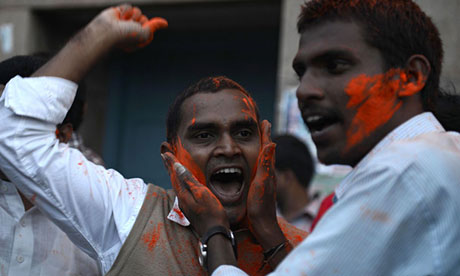
Ruling coalition led by Congress party votes in favour of hiving off part of Andhra Pradesh to create India's 29th state
India's ruling coalition government, led by the Congress party, has backed demands for the creation of a new state called Telangana in southern India, immediately spurring activists to repeat other long-standing demands for similar measures elsewhere in the vast country.
The new state - India's 29th - would be carved out of the existing southern state of Andhra Pradesh. Activists have long argued that the drought-prone northern area of Andhra Pradesh is underdeveloped and ignored by powerful politicians from the south.
Residents of the 10 districts that form Telangana say they are discriminated against in the allocation of state funds, water and jobs. The state is currently run from Hyderabad, a city known for its booming information technology industry.
The large size of some of India's 28 states makes them difficult to administer and has prompted movements to divide them. Telangana would have a population of around 35 million.
The decision is likely to be opposed by the rest of Andhra Pradesh, primarily because the proposed Telangana state would include Hyderabad, though the city would be shared.
The decision is controversial. Police and paramilitary soldiers were deployed in Hyderabad and other parts of Andhra Pradesh to prevent protests after the announcement.
The demand for a separate state has intensified since the late 1960s, with hunger strikes and violent protests claiming about 1,000 lives over the past decade. Protesters, often educated young men frustrated by the difficulty of obtaining secure employment, have publicly set fire to themselves to press for the creation of Telangana.
The protests gained strength in 2009 when veteran politician K Chandrasekhara Rao began a hunger strike. After 11 days the federal government agreed to split the state but then delayed a decision during sporadic protests both for and against the separation.
This new decision may simply be rooted in electoral arithmetic. The Congress party has struggled in recent years in Andhra Pradesh and faces a tough fight there and nationally in parliamentary elections likely to take place next year.
Critics said the split would spur other demands for new states. "The government has opened a Pandora's box. This will give rise to similar demands from several regions that are fighting for separate states," said Kalyani Shankar, a political commentator.
The growth of regional identities is seen as one of the major political and cultural trends of recent years in India. But there have been no new states since 2000, when Chhattisgarh and Jharkhand were created in the centre of the country. The new Himalayan foothill state of Uttarakhand also came into existence.
Several parts of India - the Bundelkhand region in the central state of Madhya Pradesh, Vidarbha in western Maharashtra state and Gorkhaland in the eastern West Bengal state - have similar statehood movements but the government has not made any moves to create states there.
Some in the wealthiest part of the immense, poverty-stricken northern state of Uttar Pradesh have advocated breaking away too.
On Tuesday leaders of the Gorkhaland movement called for a three-day strike in the northern parts of West Bengal to press their demand. "Our demand for Gorkhaland is older than the demand for Telangana. If the government announces a Telangana state then it should also declare a Gorkhaland state," Gorkhaland leader Bimal Grung said.
The new state is still far from reality - the decision still has to be ratified by local lawmakers and implemented.



Comment: